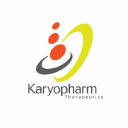/ factorpad.com / stocks / f21kwz.html
An ad-free and cookie-free website.
Our quantitative data points are meant to provide a high-level understanding of factors in equity risk models for Karyopharm Therapeutics Inc. Portfolio managers use these models to forecast risk, optimize portfolios and review performance.
We show how KPTI stock compares to 2,000+ US-based stocks, and to peers in the Manufacturing sector and Pharmaceutical Preparation Manufacturing industry.
Please do not consider this data as investment advice. Data is downloaded from sources we deem reliable, but errors may occur.
 Karyopharm Therapeutics Inc. is a commercial-stage pharmaceutical company pioneering novel cancer therapies and dedicated to the discovery, development, and commercialization of novel first-in-class drugs directed against nuclear export and related targets for the treatment of cancer and other major diseases. Karyopharm's Selective Inhibitor of Nuclear Export (SINE) compounds function by binding with and inhibiting the nuclear export protein XPO1 (or CRM1). Karyopharm's lead compound, XPOVIO® (selinexor), is approved in the U.S. in multiple hematologic malignancy indications, including in combination with Velcade® (bortezomib) and dexamethasone for the treatment of patients with multiple myeloma after at least one prior therapy, in combination with dexamethasone for the treatment of patients with heavily pretreated multiple myeloma and as a monotherapy for the treatment of patients with relapsed or refractory diffuse large B-cell lymphoma. A Marketing Authorization Application for NEXPOVIO® (selinexor) for patients with heavily pretreated multiple myeloma is also currently under review by the European Medicines Agency. In addition to single-agent and combination activity against a variety of human cancers, SINE compounds have also shown biological activity in models of neurodegeneration, inflammation, autoimmune disease, certain viruses and wound-healing. Karyopharm has several investigational programs in clinical or preclinical development.
Karyopharm Therapeutics Inc. is a commercial-stage pharmaceutical company pioneering novel cancer therapies and dedicated to the discovery, development, and commercialization of novel first-in-class drugs directed against nuclear export and related targets for the treatment of cancer and other major diseases. Karyopharm's Selective Inhibitor of Nuclear Export (SINE) compounds function by binding with and inhibiting the nuclear export protein XPO1 (or CRM1). Karyopharm's lead compound, XPOVIO® (selinexor), is approved in the U.S. in multiple hematologic malignancy indications, including in combination with Velcade® (bortezomib) and dexamethasone for the treatment of patients with multiple myeloma after at least one prior therapy, in combination with dexamethasone for the treatment of patients with heavily pretreated multiple myeloma and as a monotherapy for the treatment of patients with relapsed or refractory diffuse large B-cell lymphoma. A Marketing Authorization Application for NEXPOVIO® (selinexor) for patients with heavily pretreated multiple myeloma is also currently under review by the European Medicines Agency. In addition to single-agent and combination activity against a variety of human cancers, SINE compounds have also shown biological activity in models of neurodegeneration, inflammation, autoimmune disease, certain viruses and wound-healing. Karyopharm has several investigational programs in clinical or preclinical development.
Many of the following risk metrics are standardized and transformed into quantitative factors in institutional-level risk models.
Rankings below represent percentiles from 1 to 100, with 1 being the lowest rating of risk.
Stocks with higher beta exhibit higher sensitivity to the ups and downs in the market. (↑↑)
Stocks with higher market capitalization often have lower risk. (↑↓)
Higher average daily dollar volume over the past 30 days implies lower liquidity risk. (↑↓)
Higher price momentum stocks, aka recent winners, equate to lower risk for many investors. (↑↓)
Style risk factors often include measures of profitability and payout levels.
Companies with higher earnings generally provide lower risk. (↑↓)
Companies with higher dividend yields, if sustaintable, are perceived to have lower risk. (↑↓)
/ factorpad.com / stocks / f21kwz.html
A newly-updated free resource. Connect and refer a friend today.